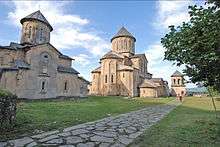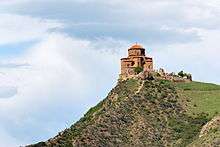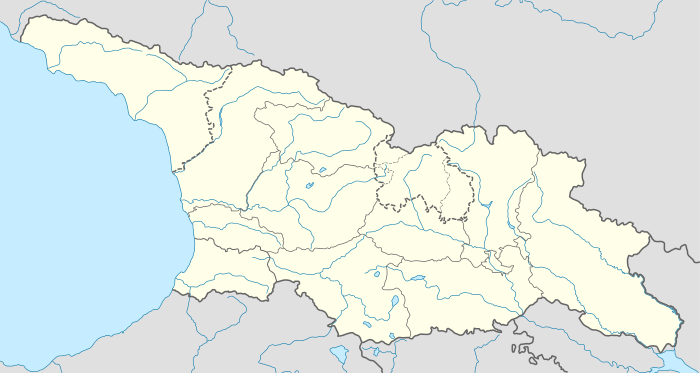List of World Heritage sites in Georgia (country)
This is a list of World Heritage sites in Georgia as inscribed on the World Heritage List of the United Nations Educational, Scientific and Cultural Organization (UNESCO). The World Heritage sites are places of importance to cultural or natural heritage as described in the UNESCO World Heritage Convention, established in 1972.[1] Georgia accepted the convention on 4 November 1992, making its sites eligible for inclusion on the list. As of 2018, there are three World Heritage sites in Georgia, all of which are cultural sites.[2]
In addition to its inscribed sites, Georgia also maintains fifteen properties on its tentative list.[3]
World Heritage sites
- Site; named after the World Heritage Committee's official designation[4]
- Location; at city, regional, or provincial level and geocoordinates
- Criteria; as defined by the World Heritage Committee[5]
- Area; in hectares and acres. If available, the size of the buffer zone has been noted as well. A lack of value implies that no data has been published by UNESCO
- Year; during which the site was inscribed to the World Heritage List
- Description; brief information about the site, including reasons for qualifying as an endangered site, if applicable
| Site | Image | Location | Criteria | Area ha (acre) |
Year | Description |
|---|---|---|---|---|---|---|
| Gelati Monastery |  |
Imereti 42°15′44″N 42°42′59″E / 42.26222°N 42.71639°E |
Cultural: (iv) |
7.87 (19.4) | 1994 | Gelati Monastery, a masterpiece of the Georgian Golden Age, was built in 1106 by King David IV and was one of the main cultural and intellectual centers in Georgia throughout the Middle Ages. It had an Academy which employed some of the most celebrated Georgian scientists, theologians and philosophers, many of whom had previously been active at various orthodox monasteries abroad, one of which was the Mangan Academy in Constantinople. In 2010–2017, the site, also including the Bagrati Cathedral, was listed as endangered due to the cathedral undergoing major reconstruction detrimental to its integrity and authenticity. In 2017, Bagrati Cathedral was removed from the World Heritage list and Gelati Monastery delisted from the endangered list.[6][7] |
| Historical Monuments of Mtskheta | .jpg)  |
Mtskheta-Mtianeti 41°51′N 44°43′E / 41.850°N 44.717°E |
Cultural: (iii)(iv) |
— | 1994 | The historic churches of Mtskheta, former capital of Georgia, are outstanding examples of medieval religious architecture in the Caucasus. They show the high artistic and cultural level attained by this ancient kingdom. The classification includes two of Georgia's most ancient religious structures: the Svetitskhoveli (Cathedral of the Living Pillar) and the Jvari Monastery (Monastery of the Cross), as well as the historical area of Mtskheta in which the two are situated. The monuments trace their origin to the dawn of Christianity in Georgia in the first half of the first millennium A.D. and were judged by UNESCO to be a testament of "the high artistic and cultural level attained by this ancient kingdom." |
| Upper Svaneti |  |
Mestia District, Samegrelo-Zemo Svaneti 42°54′59″N 43°0′41″E / 42.91639°N 43.01139°E |
Cultural: (iv)(v) |
1.06 (2.6); buffer zone 19 (47) | 1996 | These upper lands of Georgia's alpine region of Svaneti were recognized by UNESCO as an "exceptional example of mountain scenery with medieval-type villages and tower-houses", which were often family-built and served to protect against invaders for centuries. [8] |
Tentative list
In addition to sites inscribed on the World Heritage list, member states can maintain a list of tentative sites that they may consider for nomination. Nominations for the World Heritage list are only accepted if the site was previously listed on the tentative list.[9] As of 2018, Georgia maintains fifteen properties on its tentative list:[3]
- Alaverdi Cathedral
- Ananuri
- Colchis Wetlands and Forests
- David Gareji Monasteries and Hermitage
- Dmanisi Hominid Archaeological Site
- Gremi Church of Archangels and Royal Tower
- Kvetera Church
- Mta-Tusheti
- Nicortsminda Cathedral
- Samtavisi Cathedral
- Shatili
- Tbilisi Historic District
- Uplistsikhe Cave Town
- Vani
- Vardzia-Khertvisi
See also
References
- ↑ "The World Heritage Convention". UNESCO. Retrieved 21 September 2010.
- ↑ "Georgia". UNESCO. Retrieved 6 August 2018.
- 1 2 "Tentative List – Georgia". UNESCO. Retrieved 6 August 2018.
- ↑ "World Heritage List". UNESCO. Retrieved 28 May 2010.
- ↑ "The Criteria for Selection". UNESCO. Retrieved 10 September 2011.
- ↑ Centre, UNESCO World Heritage. "Gelati Monastery, Georgia, removed from UNESCO's List of World Heritage in Danger". whc.unesco.org. Retrieved 23 April 2018.
- ↑ Bagrati Cathedral and Gelati Monastery UNESCO. Retrieved: June 5, 2013
- ↑ "Upper Svaneti". UNESCO. Retrieved 17 Aug 2011.
- ↑ "Tentative Lists". UNESCO. Retrieved 7 October 2010.
External links
| Wikimedia Commons has media related to World Heritage Sites in Georgia. |


